Madhava Nidana Chapter 55 Kshudra Roga Nidanam
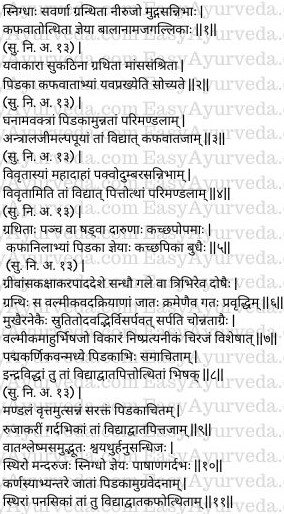
This article explains Madava nidana 55th chapter “Kshudra Roga Nidanam”. Causes, pathology and symptoms of Kshudra Roga are explained in this chapter. Kshudra Roga means minor disease.
Table of Contents
Ajagallika
A disease characterised by appearance of papules which are unctuous (waxy, oily), having the same colour of the skin (not discoloured), having cystic appearance (nodular), devoid of pain and resemble green gram (in size and appearance), caused by abnormal increase of kapha and vata together, especially occurring in children, is called by the name ajagallika. (1)
Read – Kshudra Roga: Minor Diseases: Symptoms, Ayurvedic Treatment

Yavaprakhya
Papules of the size of barley, hard, nodular, localized in the muscles and caused by combined vitiation of kapha and vata is known as Yavaprakhya. (2)
Antralaji
A big (stout) papule without an opening, raised, round in shape, having less quantity of pus in it and caused by simultaneous aggravation of kapha and vata is known as Antralaji (or Andhalaji). (3)
Vivruta
That which has a wide opening, is associated with severe burning sensation, is of the colour (size) of a ripened udumbara fruit (Ficus glomerata), round in shape, and produced by increased pitta is known as Vivrta. (4)
Kacchapika
Five or six piḍakaas (papules), nodular (hard), resembling the shell of a tortoise caused by increased kapha and vaata together is named as Kacchapika by the wise. (5)
Valmika
A granthi (tumour / cystic swelling) caused by increase of all the three doshas together, resembling an ants’ hill, appear in the neck, shoulder (shoulder blade, scapular region), axilla (arm pits), hands, feet, bony joints or throat regions. If this is not treated properly on time, it gradually increases in size. It will have many mouths (openings) discharging fluids, with pricking pain, spreading to other parts of the body like visarpa (erysipelas), with pointed sprouts. Such a chronic disease (which has not been treated for a long time) is incurable and has been named as Valmika by the wise physicians. (6-7)
Indraviddha
Small pidakaas (papules) spread out in the centre, resembling the central part of a lotus flower – which consists of seeds of lotus centered in a capsule, caused by increased vata and pitta together is known to physicians as Indraviddha. (8)
Gardhabhika
Round, elevated, red mandalas (patches), studded with small pidakas (papules) causing pain is known as Gardhabhika. This condition is caused by vatapitta – vata and pitta increased together. (9)
Read – Blisters: Ayurvedic Understanding, Treatment Principles
Pasanagardabha
A sotha (swelling) which is caused due to simultaneous vitiation of vata and kapha, manifesting in the joint of the lower jaw, which is fixed (hard), has mild pain and is unctuous (greasy, oily appearance) is known as Paasanagardabha (10).
Panasika
A pidaka (papule) occurring inside the ear, associated with severe pain, is fixed (hard) and caused by increased vata and kapha together is known as Panasika. (11)
Read – Kapha Dosha – General introduction
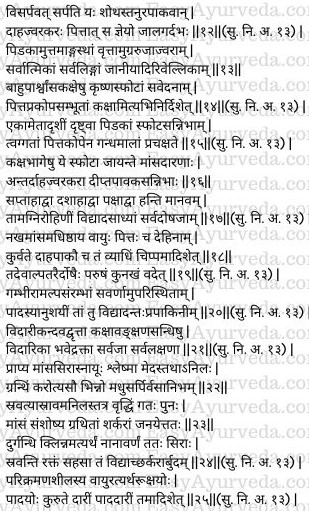
Jalagardabha
A thin swelling which spreads quickly like visarpa (herpes, erysipelas), without undergoing suppuration (without pus being formed) and associated with burning sensation and fever, caused by increased pitta is known as Jalagardabha. (12)
Irivellika
A pidaka (papule) which occurs on the head, round, associated with severe pain, fever, caused by all the three doshas and having symptoms of increase of all the three doshas together, is known as Irivellika. (13)
Kaksa
Black coloured painful sphota (vesicle) appearing on arms, flanks, or sides of the arms, shoulders (shoulder blade, scapular region), or axillae, caused due to increase of pitta is known as Kaksa. (14)
Gandhamala
A single papule which is similar to the above-mentioned vesicle (which is similar to that explained in Kaksa – in the above context) manifesting superficially on the skin, which bursts out and is caused by increased pitta is called Gandhamala. (15)
Read – Pitta Dosha – General Introduction
Agnirohini
Sphotas (vesicles) developing in the axillae, which tears or bursts (burrow) deep into the muscles (and destroy them), associated with severe burning sensation inside the body and fever as if being enveloped by burning fire (being burnt by fire), which kills the patient within seven, ten or fifteen days is known as Agnirohini. It is caused by all the three doshas (aggravated together) and is said to be incurable. (16-17)
Cippa
Vata and pitta which have undergone increase together get lodged in the muscles in and around the nails and produce burning sensation and suppuration (formation of pus) therein. This disease is called as Chippa. Kunakha is a similar condition caused by mild increase of doshas. (18-19)
Read – Paronychia: Ayurvedic treatment and Home remedies
Anusayi
A mild swelling which occurs on the upper portion of the foot and suppurates (produces pus) from deep inside and thus deep seated, has same colour of the skin (no discolouration), is known as Anusayi. (20)
Vidarika
A round papule resembling vidarikanda (tuber of Pueraria tuberosa), manifesting in the joints around axillae or groins, red in colour, caused by and presenting the symptoms of all the three doshas together is known as Vidarika. (21)
Sarkararbudam
Kapha, medas and vata undergoing increase invade the muscles, veins and ligaments (tendons, nerves), and produce a granthi (cystic swelling, tumour). When it bursts open discharges (exudates) resembling honey, ghee or muscle fat flow out of it. In due course of time, the vata aggravated (as an effect of destruction of tissues) dries up the muscles and produces small nodules which appear like sand particles in the muscles. Due to this, the veins instantly discharge excessive foul-smelling blood, containing watery content and of different colours. This condition is called as Sarkararbuda. (22-24)
Read – Granthi: Cystic Swelling, Types, Features, Ayurvedic Treatment
Padadari
In persons who are in the habit of walking too much (on rough ground without footwear), the vata gets aggravated and produces fissures in the extremely dried (soles of the) feet. This condition is known as Padadari. (25)
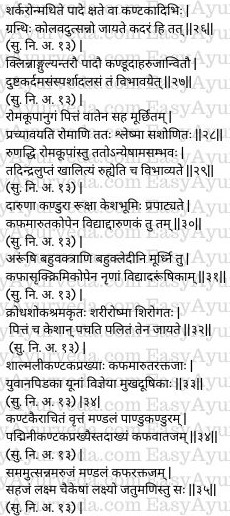
Kadara
When the foot gets pressed by (due to walking on) gravel or rough stones (without footwear) or gets injured (due to prick by) thorns etc, small (cystic) raised swelling of the size of a jujube fruit (Ziziphus jujuba) develop on (the sole) them. This condition is known as Kadara. (26)
Read – Ber Fruit: Indian Jujube Uses, Dose, Side Effect, Research
Alasa
Alasa is a disease characterized by ulcers formed between the toes from which discharges (exudation) occur (dampness between the toes), associated with itching, burning sensation and pain. This is caused by contact with contaminated slush. (27)
Indralupta
Increased pitta (Bhrajaka subtype) presents at the root of the body hairs, on getting association with (increased) vata, causes the hairs to fall off. Following this, increased kapha and blood together block the hair follicles (pores). This will not allow the new hairs to grow. This condition is known as Indralupta, Khalitya or Ruhya. (28-29)
Read – Alopecia: Ayurveda Concept, Causes, Treatment, Medicines
Darunaka
The skin on the scalp gets cracked, becomes hard (rough) and dry and will itch due to increase of kapha and vata together. This is known as Darunaka. (30)
Arumshika
Small ulcers with many openings manifesting on the skin of the scalp, having discharges, caused due to aggravation of kapha, blood and worms (bacteria, infection) are called as Arumsika. (31)
Palita
The heat of the body produced by frequent bouts of anger, grief and physical strain (fatigue) reach the head along with increased pitta and make the hairs grey. This condition in which there is greying of hairs is known as palita. (32)
Read – Fatigue: Ayurvedic Treatment And Medicines
Yuvanapidaka
Papules resembling the sprouts (thorns, spikes) on the bark of salmali tree (Bombax malabaricum) appear on the face of adolescents caused by increase of kapha, vata and blood together is known as yuvanapidaka or mukhsdusika. (33)
Padminikantaka
Circular, pale (white) and itchy patches, studded with papules resembling thorn like projections of lotus flower, caused by increased kapha and vata together is called as Padminikantaka. (34)
Jatumani
A congenital, even or slightly elevated, painless patch on the skin caused by increased kapha and rakta (blood) together is known as jatumani. According to the opinion of other experts it is called Laksma / Janmajata Lakshana. (35)
Read – Ajagallika Meaning, Symptoms, Treatment
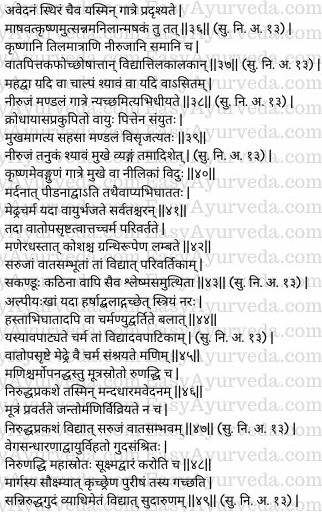
Masaka
Painless, fixed (immovable), elevated patches (nodules), black like a black-gram, appearing on the body and caused by increased vata are called as Masaka. (36)
Read – Rakta Pradoshaja Rogas – When Blood Is Vitiated By Doshas
Tilakalaka
Black, painless, even (not raised above the level of the skin) spots resembling sesame seeds, is known as Tilakälaka. They are caused when kapha is dried by increased vata and pittta in the skin. (37)
Nyaccha
Broad (big) or small, blue or black, painless patches manifested on the skin is known as Nycha. (38)
Vyanga
Vata undergoes increase due to anger and physical exertion, associated with pitta gets localized in the face and would suddenly produce painless, thin, black (blackish blue) patches on the skin. This condition is known as Vyanga. (39)
Read – Ayurvedic Treatment For Freckles And Melasma
Nilika
Similar black patches appearing on the face as well as on other parts of the body are known as Nilika. (40)
Parivartika
Due to too much indulgence in rubbing (hard friction) or squeezing (the penis) or by injury (to the penis or its skin), the vayu which is travelling throughout the body gets aggravated and reaches the skin on the penis and gets lodged therein. Being affected by the vitiated vata, the skin of the penis becomes upturned. The sac of the skin (prepuce) hangs under the glans penis in the form of a knot (appears like a cystic swelling). This condition is called parivartika. It causes pain if vata is predominant. If kapha is predominant in the same condition, it causes itching and hardness. (41-43)
Avapatika
When the man has forcible (aggressive, violent) coitus with a woman who has narrow vaginal opening due to extreme excitation or when he masturbates hard, forcibly with his hand, the skin of the glans penis forcibly gets upturned and eventually gets torn. This condition is known as Avapatika. (44-45)
Read – Charaka Chikitsa Sthana 30th Chapter – Yoni Vyapat
Niruddhaprakasa
Due to the effect of abnormally increased vata, the skin over the glans penis covers the glans tightly. The glans thus covered tightly by the skin will block the passage of urine. In this condition the urine flows out in slow streams and without any pain. The glans is always covered by the skin. This painful condition caused by increased vata is known as Niruddhaprakasa. (46-47)
Sanniruddhaguda
The vata which has got aggravated due to constant indulgence in suppression of the urge for defecation and fart (flatus) would reach the anal region (rectum) and causes blockage of the mahasrotas (rectal passage, colon) and causes narrowing of its opening (lumen). Due to the narrowing of the outlet (opening), the faeces is eliminated with difficulty. This highly distressing condition is known by the name sanniruddhaguda. (48-49)
Read – Srotas: Body Channels and Duct systems – Easy Explanation
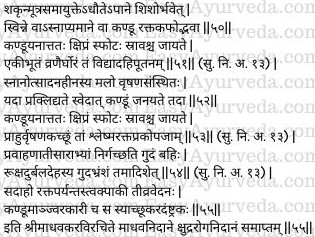
Ahiputanaka
When the faeces and urine in and around the anal region of the infants are not cleansed (washed) properly or when the anal region is not washed in spite of sweating in that area there develops itching in that region caused due to increased blood and kapha. When scratched due to itching, it quickly produces pustules and discharges (exuding pustules). The ulcers of these pustules join together to form an intractable ulcer. This condition is known as Ahiputana. (50-51)
Read – Charaka Vrana Chikitsa – 25th Chapter – Wounds, Ulcers
Vrushana kacchu
In persons who do not take bath or oil massage regularly every day, the dirt accumulated on the skin of the scrotum gets wet on getting into contact (mixed with) with the sweat therein and produces itching. This condition is known as Vrsanakacchu. It is caused by simultaneous aggravation of kapha and rakta (blood). (52-53)
Guda bhramsa
In persons who are dry (emaciated) and weak, the anus (muscles of anus) comes out due to (indulgence in) straining at defecation or due to (frequent episodes of) diarrhoea. This condition is known as Gudabhramsa. (54)
Read – Rectal Prolapse – Causes, Treatment, Useful Herbs
Varahadamstra / Sukaradamstra
The disease characterized by manifestation of skin ulcer with red edge, associated with severe burning sensation, suppuration, severe pain, itching and fever is known as Sakaradamstraka. (55)
Thus ends the chapter on Kshudra Roga Nidanam in Madhava Nidana text written by Acharya Madhavakara.










